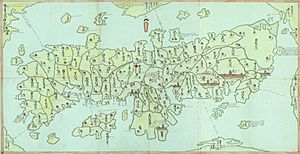Tenmei facts for kids
Tenmei (天明) was a Japanese era name (年号, nengō, lit. year name), also known as Temmei, after An'ei and before Kansei. This period started in April 1781 and ended in January 1789. During this time, the emperor was Kōkaku-tennō (光格天皇).
The nengō Tenmei means "Heavenly Radiance". The kanji means "dawn" or "daybreak".
Events of the Tenmei era
- 1782 (Tenmei 2): Great Tenmei Famine began.
- 1782 (Tenmei 2): The emperor received a written study of silver currency in China and Japan. The work was made by Minamoto no Masatsuna.
- 1783 (Tenmei 3): Mount Asama (浅間山,, Asama-yama) erupted in Shinano Province and loss of life was estimated at 20,000+.
- 1783 (Tenmei 3): Famine was worse; food reserves used up
- 1784 (Tenmei 4): Nationwide events honored Kōbō-Daishi who was the founder of Shingon Buddhism. Kōbō-Daishi died 950 years earlier.
- 1784 (Tenmei 4): The son of Tanuma Okitsugu was assassinated in Edo Castle.
- 17 September 1786 (Tenmei 6, 25th day of the 8th month): Shogun Tokugawa Ieharu died and was buried in Edo.
- 1787 (Tenmei 7): Tokugawa Ienari became the 11th shogun of the Tokugawa shogunate.
- 1787 (Tenmei 7): Matsudaira Sadanobu becomes the shogunate's senior official (rōjū).
- 1787 (Tenmei 7): Kutsuki Masatsuna published Seiyō senpu (Notes on Western Coinage).
- 1788 (Tenmei 7): Riots in rice shops in Edo and Osaka.
- 1788 (Tenmei 8): Great Fire of Kyoto; the Imperial Palace was destroyed.
Related pages
- National Diet Library, "The Japanese Calendar" -- historical overview plus illustrative images from library's collection
| Tenmei | 1st | 2nd | 3rd | 4th | 5th | 6th | 7th | 8th | 9th |
|---|---|---|---|---|---|---|---|---|---|
| 1781 | 1782 | 1783 | 1784 | 1785 | 1786 | 1787 | 1788 |
| Preceded by: An'ei |
Era or nengō: Tenmei |
Succeeded by: Kansei |

All content from Kiddle encyclopedia articles (including the article images and facts) can be freely used under Attribution-ShareAlike license, unless stated otherwise. Cite this article:
Tenmei Facts for Kids. Kiddle Encyclopedia.

